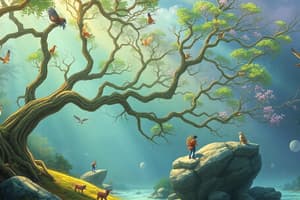Podcast
Questions and Answers
What is an ecosystem?
What is an ecosystem?
A collection of all the living and nonliving things in a given area.
How is ecology defined?
How is ecology defined?
The study of the interactions between living organisms and their environments.
What is a community in ecology?
What is a community in ecology?
Organisms from multiple species interacting in the same place.
What is the difference between a community and an ecosystem?
What is the difference between a community and an ecosystem?
What role does a wolf play when it eats a rabbit that eats grass?
What role does a wolf play when it eats a rabbit that eats grass?
What role does grass play in the food chain that includes a wolf and a rabbit?
What role does grass play in the food chain that includes a wolf and a rabbit?
What are some abiotic factors within an ecosystem?
What are some abiotic factors within an ecosystem?
What is an example of a biotic factor in an ecosystem?
What is an example of a biotic factor in an ecosystem?
Why is photosynthesis limited to surface water in marine ecosystems?
Why is photosynthesis limited to surface water in marine ecosystems?
What does a dispersion pattern refer to in ecology?
What does a dispersion pattern refer to in ecology?
What is the name of the model of maximum rate of population growth?
What is the name of the model of maximum rate of population growth?
What is an example of a producer in an aquatic ecosystem?
What is an example of a producer in an aquatic ecosystem?
What largely defines terrestrial biomes?
What largely defines terrestrial biomes?
What primarily influences the distribution of terrestrial biomes on Earth?
What primarily influences the distribution of terrestrial biomes on Earth?
What is a savanna?
What is a savanna?
Which biome is best adapted to seasonal fires?
Which biome is best adapted to seasonal fires?
What type of large animals are commonly found in the savanna?
What type of large animals are commonly found in the savanna?
Why are there no large trees in the tundra?
Why are there no large trees in the tundra?
In which zone does light reach organisms?
In which zone does light reach organisms?
What do phytoplankton and multicellular algae provide in the photic zone?
What do phytoplankton and multicellular algae provide in the photic zone?
What is the aphotic zone?
What is the aphotic zone?
What is the term for the sea floor?
What is the term for the sea floor?
What do fishes and marine mammals swim in?
What do fishes and marine mammals swim in?
What is a distinctive biome called?
What is a distinctive biome called?
Where is an estuary found?
Where is an estuary found?
What primarily defines aquatic biomes?
What primarily defines aquatic biomes?
What biome has organisms that attach to the substrate to avoid desiccation?
What biome has organisms that attach to the substrate to avoid desiccation?
Where would a coral reef most likely be found?
Where would a coral reef most likely be found?
Flashcards are hidden until you start studying
Study Notes
Ecosystems and Ecology
- An ecosystem consists of living (biotic) and nonliving (abiotic) elements in a specified area.
- Ecology studies the interactions between living organisms and their environments.
- A community comprises multiple species interacting in a specific location, excluding their environment.
- The main difference between a community and an ecosystem is that the latter includes the surrounding environment.
Food Webs and Energy Flow
- In a food chain example, a wolf is classified as a consumer while grass is identified as a producer.
- Producers, such as phytoplankton, convert light energy through photosynthesis to create food.
- Abiotic factors within an ecosystem include nutrients, energy, and fire, while biotic factors relate to living components, like moss.
Marine Ecosystems
- Photosynthesis is limited to surface waters in marine ecosystems due to insufficient visible light penetration in deeper waters.
- The photic zone is where light penetrates and supports photosynthetic organisms such as phytoplankton and algae, providing food for various marine species.
- In contrast, the aphotic zone lacks sufficient light to support photosynthesis.
Biomes and Their Characteristics
- Terrestrial biomes are largely defined by the types of plants inhabiting them.
- The distribution of these biomes is influenced predominantly by temperature and rainfall levels.
- Savannas feature a warm climate with grasses and scattered trees, while chaparral is adapted to seasonal fires.
- The tundra biome lacks large trees because the ground remains frozen throughout the year.
Aquatic Biomes
- Aquatic biomes are primarily categorized by salinity levels.
- The benthic realm refers to the sea floor, while the pelagic realm covers open water inhabited by fish and marine mammals.
- Estuaries occur where freshwater streams merge with the ocean and can be vital for various marine organisms.
Ecological Zones
- An intertidal zone supports organisms that have developed mechanisms to attach to surfaces and resist drying out.
- Coral reefs are typically found within the oceanic photic zone, where light allows for rich biodiversity.
Studying That Suits You
Use AI to generate personalized quizzes and flashcards to suit your learning preferences.




